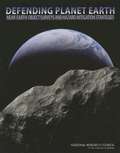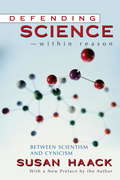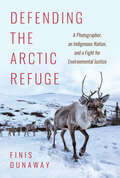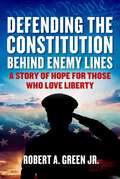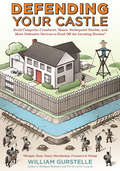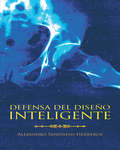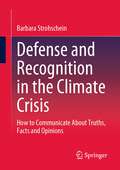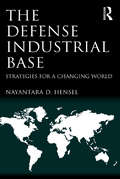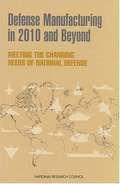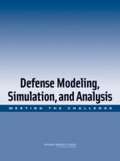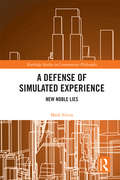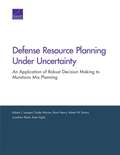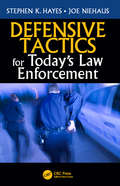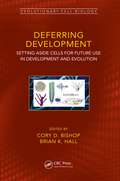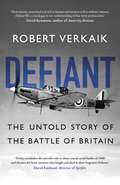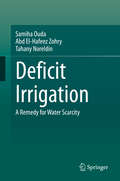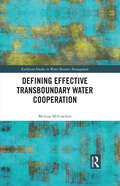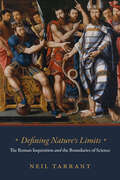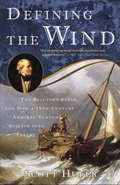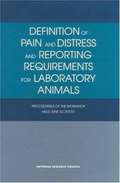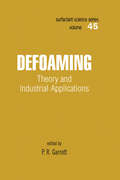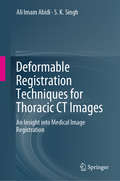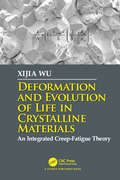- Table View
- List View
Defending Planet Earth: Near-Earth-Object Surveys and Hazard Mitigation Strategies
by National Research Council of the National AcademiesThe United States spends approximately four million dollars each year searching for near-Earth objects (NEOs). The objective is to detect those that may collide with Earth. The majority of this funding supports the operation of several observatories that scan the sky searching for NEOs. This, however, is insufficient in detecting the majority of NEOs that may present a tangible threat to humanity. A significantly smaller amount of funding supports ways to protect the Earth from such a potential collision or "mitigation." In 2005, a Congressional mandate called for NASA to detect 90 percent of NEOs with diameters of 140 meters of greater by 2020. Defending Planet Earth: Near-Earth Object Surveys and Hazard Mitigation Strategies identifies the need for detection of objects as small as 30 to 50 meters as these can be highly destructive. The book explores four main types of mitigation including civil defense, "slow push" or "pull" methods, kinetic impactors and nuclear explosions. It also asserts that responding effectively to hazards posed by NEOs requires national and international cooperation. Defending Planet Earth: Near-Earth Object Surveys and Hazard Mitigation Strategies is a useful guide for scientists, astronomers, policy makers and engineers.
Defending Science - within Reason
by Susan HaackSweeping in scope, penetrating in analysis, and generously illustrated with examples from the history of science, this new and original approach to familiar questions about scientific evidence and method tackles vital questions about science and its place in society. Avoiding the twin pitfalls of scientism and cynicism, noted philosopher Susan Haack argues that, fallible and flawed as they are, the natural sciences have been among the most successful of human enterprises-valuable not only for the vast, interlocking body of knowledge they have discovered, and not only for the technological advances that have improved our lives, but as a manifestation of the human talent for inquiry at its imperfect but sometimes remarkable best.This wide-ranging, trenchant, and illuminating book explores the complexities of scientific evidence, and the multifarious ways in which the sciences have refined and amplified the methods of everyday empirical inquiry; articulates the ways in which the social sciences are like the natural sciences, and the ways in which they are different; disentangles the confusions of radical rhetoricians and cynical sociologists of science; exposes the evasions of apologists for religious resistance to scientific advances; weighs the benefits and the dangers of technology; tracks the efforts of the legal system to make the best use of scientific testimony; and tackles predictions of the eventual culmination, or annihilation, of the scientific enterprise.Writing with verve and wry humor, in a witty, direct, and accessible style, Haack takes readers beyond the "Science Wars" to a balanced understanding of the value, and the limitations, of the scientific enterprise.
Defending the Arctic Refuge: A Photographer, an Indigenous Nation, and a Fight for Environmental Justice (Flows, Migrations, and Exchanges)
by Finis DunawayTucked away in the northeastern corner of Alaska is one of the most contested landscapes in all of North America: the Arctic National Wildlife Refuge. Considered sacred by Indigenous peoples in Alaska and Canada and treasured by environmentalists, the refuge provides life-sustaining habitat for caribou, polar bears, migratory birds, and other species. For decades, though, the fossil fuel industry and powerful politicians have sought to turn this unique ecosystem into an oil field. Defending the Arctic Refuge tells the improbable story of how the people fought back. At the center of the story is the unlikely figure of Lenny Kohm (1939–2014), a former jazz drummer and aspiring photographer who passionately committed himself to Arctic Refuge activism. With the aid of a trusty slide show, Kohm and representatives of the Gwich'in Nation traveled across the United States to mobilize grassroots opposition to oil drilling. From Indigenous villages north of the Arctic Circle to Capitol Hill and many places in between, this book shows how Kohm and Gwich'in leaders and environmental activists helped build a political movement that transformed the debate into a struggle for environmental justice. In its final weeks, the Trump administration fulfilled a long-sought dream of drilling proponents: leasing much of the Arctic Refuge coastal plain for fossil fuel development. Yet the fight to protect this place is certainly not over. Defending the Arctic Refuge traces the history of a movement that is alive today—and that will continue to galvanize diverse groups to safeguard this threatened land.
Defending the Constitution behind Enemy Lines: A Story of Hope for Those Who Love Liberty (Children’s Health Defense)
by Robert A. Green Jr.The story of a silenced minority who put their constitutional oaths before all else to keep our Founding Fathers' great gift of liberty alive. Defending the Constitution Behind Enemy Lines is an explosive, tell-all book, detailing the military COVID-19 vaccine mandate, and the resistance to that mandate by service members who could not, in good conscience, go along. As an actively serving Navy Commander, Robert A. Green Jr. removes the veil of military secrecy and complexity to shed light on the related unlawfulness and the official cover-up being committed by certain DoD leaders. His deep dive into the current crisis details the harms perpetrated against service members and their families as well as the destruction of military readiness that resulted. Standing upon his First Amendment rights, the first-time author analyzes the current crisis in light of the challenges faced by our Founding Fathers. His message to the American people is clear: The crisis our military is facing will only be solved by following in the footsteps of our Founding Fathers and returning to an adherence to the Constitution that our forebears sacrificed everything to leave us.
Defending Your Castle: Build Catapults, Crossbows, Moats, Bulletproof Shields, and More Defensive Devices to Fend Off the Invading Hordes
by William GurstelleA man's home is his castle, or so the saying goes, but could it withstand an attack by Attila and the Huns, Ragnar and the Vikings, Alexander and the Greeks, Genghis Khan and the Mongols, or Tamerlane and the Tartars? Backyard Ballistics author William Gurstelle poses this fascinating question to modern-day garage warriors and shows them how to build an arsenal of ancient artillery and fortifications aimed at withstanding these invading hordes. Each chapter introduces a new bad actor in the history of warfare, details his conquests, and features weapons and fortifications to defend against him and his minions. Clear step-by-step instructions, diagrams, and photographs show how to build a dozen projects, including "Da Vinci's Catapult," "Carpini's Crossbow," a "Crusader-Proof Moat," "Alexander's Tortoise," and the "Cheval-de-frise." With a strong emphasis on safety, the book also gives tips on troubleshooting, explains the physics behind many of the projects, and shows where to buy the materials. By the time they've reached the last page, at-home defenders everywhere will have succeeded in creating a fully fortified home.
Defensa del diseño inteligente
by Alejandro SanvisensLa teoría del diseño inteligente considera que la estructura de la materia, del cosmos y de los seres vivos manifiesta un diseño, un proyecto concebido por una inteligencia divina. <P><P>En este libro se dan a conocer los principales indicios de este diseño a través de la complejidad de los seres vivos, del origen de la vida, de la estructura y las leyes de la materia y del desarrollo cósmico. Se defiende la teoría del diseño inteligente de los ataques que ha recibido por parte de los principales representantes del ateísmo contemporáneo.
Defense and Recognition in the Climate Crisis: How to Communicate About Truths, Facts and Opinions
by Barbara StrohscheinTruths, facts and opinions on the climate issue are often met with psychological or social defense, both publicly and privately. Based on selected psychological and philosophical theories as well as data material, this book shows how defense comes about, how it works, and how, on the other hand, the necessary recognition can succeed on various levels. It is only through recognition that constructive discourse becomes possible. This book offers all the basics to be able to theoretically and practically solve communication conflicts between defense and recognition in the climate crisis.
The Defense Industrial Base: Strategies for a Changing World
by Nayantara HenselThe US and international defense industrial sectors have faced many challenges over the last twenty years, including cycles of growth and shrinkage in defense budgets, shifts in strategic defense priorities, and macroeconomic volatility. In the current environment, the defense sector faces a combination of these challenges and must struggle with the need to maintain critical aspects of the defense industrial base as defense priorities change and as defense budgets reduce or plateau. Moreover, the defense sector in the US is interconnected both with defense sectors in other countries and with other industry sectors in the US and global economies. As a result, strategic decisions made in one defense sector impact the defense sectors of other countries, as well as other areas of the economy. Given her academic, corporate, and Department of Defense experience as a leading economist and policy-maker, Dr. Nayantara Hensel is perfectly positioned to examine the interrelationship between these forces both historically and in the current environment, and to assess the implications for the future global defense industrial base.
Defense Manufacturing in 2010 and Beyond: Meeting the Changing Needs of National Defense
by National Research CouncilThe end of the Cold War, the evolving mission of the U.S. Armed Services, the dramatic improvements in commercial manufacturing--these and other trends are changing how we provide for the common defense. What will we need in the way of defense manufacturing in the year 2010--a short few years away? How should we best spend our defense funds?Defense Manufacturing in 2010 and Beyond sets forth a vision for the nation's defense manufacturing, including policies, technologies, systems, processes, practices, and financial implications. Eight specific trends are forecast--defense spending, the relationship between defense and commerical industries, the nature of the threat to our nation, the emergence of new technologies, and other areas--and their implications for defense manufacturing are explored.The committee describes manufacturing advancements that are around the corner--virtual enterprise, and more--and examines how these breakthroughs will likely meet or fail to meet defense manufacturing requirements. This expert panel identifies the highest priorities and recommends strategies for matching future manufacturing capabilities with our defense needs. February
Defense Modeling, Simulation, and Analysis: MEETING THE CHALLENGE
by National Research Council of the National AcademiesModeling, simulation, and analysis (MS&A) is a crucial tool for military affairs. MS&A is one of the announced pillars of a strategy for transforming the U.S. military. Yet changes in the enterprise of MS&A have not kept pace with the new demands arising from rapid changes in DOD processes and missions or with the rapid changes in the technology available to meet those demands. To help address those concerns, DOD asked the NRC to identify shortcomings in current practice of MS&A and suggest where and how they should be resolved. This report provides an assessment of the changing mission of DOD and environment in which it must operate, an identification of high-level opportunities for MS&A research to address the expanded mission, approaches for improving the interface between MS&A practitioners and decision makers, a discussion of training and continuing education of MS&A practitioners, and an examination of the need for coordinated military science research to support MS&A.
A Defense of Simulated Experience: New Noble Lies (Routledge Studies in Contemporary Philosophy)
by Mark SilcoxThis book defends an account of the positive psychological, ethical, and political value of simulated human experience. Philosophers from Plato and Augustine to Heidegger, Nozick, and Baudrillard have warned us of the dangers of living on too heavy a diet of illusion and make-believe. But contemporary cultural life provides broader, more attractive opportunities to do so than have existed at any other point in history. The gentle forms of self-deceit that such experiences require of us, and that so many have regarded as ethically unwholesome or psychologically self-destructive, can in fact serve as vital means to political reconciliation, cultural enrichment, and even (a kind of) utopia. The first half of the book provides a highly schematic definition of simulated experience and compares it with some claims about the nature of simulation made by other philosophers about what it is for one thing to be a simulation of another. The author then provides a critical survey of the views of some major authors about the value of certain specific types of simulated experience, mainly in order to point out the many puzzling inconsistencies and ambiguities that their thoughts upon the topic often exhibit. In the second half of the book, the author defends an account of the positive social value of simulated experience and compares his own position to the ideas of a number of utopian political thinkers, as well as to Plato's famous doctrine of the "noble lie." He then makes some tentative practical suggestions about how a proper appreciation of the value of simulated experience might influence public policy decisions about such matters as the justification of taxation, paternalistic "choice management," and governmental transparency. A Defense of Simulated Experience will appeal to a broad range of philosophers working in normative ethics, aesthetics, the philosophy of technology, political philosophy, and the philosophy of culture who are interested in questions about simulated experience. The book also makes a contribution to the emerging field of Game Studies.
Defense Resource Planning Under Uncertainty
by Jonathan Klenk Kate Giglio Robert J. Lempert Drake Warren Robert W. Button Ryan HenryDefense planning faces significant uncertainties. This report applies robust decision making (RDM) to the air-delivered munitions mix challenge. RDM is quantitative, decision support methodology designed to inform decisions under conditions of deep uncertainty and complexity. This proof-of-concept demonstration suggests that RDM could help defense planners make plans more robust to a wide range of hard-to-predict futures.
Defensive Tactics for Today’s Law Enforcement
by Stephen K. Hayes Joe NiehausFew of the many defensive tactics books on the market include the training and methods of martial arts. Drawing on the centuries-old techniques of Ninjutsu, Defensive Tactics for Today’s Law Enforcement offers alternatives to the traditional police defensive tactics taught to most officers. This text stresses relying on natural tendencies in a violent encounter to ensure officer safety and to better utilize the techniques and training officers do receive. By integrating existing training with martial arts expertise, Defensive Tactics provides officers access a full complement of techniques to better navigate physical conflict safely and effectively. Intended for law enforcement practitioners, as well as practitioners of any other professions that present a personal security risk, Defensive Tactics for Today’s Law Enforcement will better equip readers with a diverse range of defensive tactics.
Deferring Development: Setting Aside Cells for Future Use in Development and Evolution (Evolutionary Cell Biology)
by Cory Douglas Bishop Brian K. HallThis volume examines cells set aside during development for use later in ontogeny or in adult life. There is no single term for such cells. The cells explored fall within several major categories — stem cells, set-aside cells (in echinoderm larvae), imaginal discs in insects such as Drosophila, meristems (plants), blastemata (regeneration in amphibians), neoblasts (regeneration in planarians). The book compares and contrasts these cell types and the environments (niches) in which they operate with the aim of unravelling any relationships between them, between their activation in development, and in their evolution. Key Features Explores the nature of deferred-use cells in evolutionary and developmental context. Reviews the mechanisms of development of set-aside cells, such as stem cells, meristems, and imaginal discs. Provides phylogenetic overview of different types of deferred-use cells. Compares and contrasts different theories on the origin of deferred-use cells. Related Titles Calegari, F. & C. Waskow, eds. Stem Cells: From Basic Research to Therapy (ISBN 978-1-4822-0775-0) Cabral, J. M. S. & C. L. da Silva, eds. Bioreactors for Stem Cell Expansion and Differentiation (ISBN 978-1-4987-9590-6) Kong, H., A. J. Putnam, & L. B. Schook, eds. Stem Cells and Revascularization Therapies (ISBN 978-1-4398-0323-3) Schaffer, D., J. D. Bronzino, & D. R. Peterson, eds. Stem Cell Engineering: Principles and Practices (ISBN 978-1-4398-7204-8)
Defiant: The Untold Story of the Battle of Britain
by Robert Verkaik'Defiant is both a stirring testament to the courage of the men who flew them and a welcome new examination of one of the Second World War's most famous conflicts'Alexander Larman, ObserverIn this startling new perspective on the Battle of Britain, Robert Verkaik reveals the surprising truth about the battle's forgotten fighter, the Boulton Paul Defiant.The crucial role played by the Spitfire and the Hurricane has been exhaustively recorded, but, to date, next to nothing has been written about the third British fighter which took part in the battle. By writing from the unique perspective of the pilots who flew the Defiant and their air-gunners, Verkaik helps to set the record straight. The Air Staff regarded the Defiant as a state-of-the-art bomber destroyer and wanted to equip a third of all Fighter Command squadrons with this new plane. But the head of Fighter Command, Hugh Dowding, had other ideas and went to war with Whitehall over its plan to saddle him with hundreds of 'obsolete' turret fighters. Then at Dunkirk, a Defiant squadron scored a huge success against the Luftwaffe by shooting down more German planes in one day than any other RAF unit before or since. Fighter Command, enthusiastically urged on by the Air Ministry, now committed its third fighter to the coming air battle over southern England. In the desperate dogfights of the battle, Defiants shot down both German bombers and fighters but suffered heavy losses too - one squadron was almost wiped out when it was ambushed by a superior force of Messerschmitt 109s. On 30 August 1940 all Defiant squadrons were withdrawn from the front line. The families of the Defiant air crews believed that their husbands, brothers and sons had died in vain, but the truth is that their vital contribution to the battle over Dunkirk and their role in the Battle of Britain has been all but erased from the official history. The story of the Defiant has not been allowed to mar the glorious victory won by the Spitfire and the Hurricane.But Verkaik has uncovered new records, including top-secret memos written by Hugh Dowding and his deputy Keith Park as well as correspondence with the Air Staff, combat and squadron reports, pilot logs and recordings of the last interviews with Defiant crews. He has also succeeded in tracing relatives of Defiant pilots and gunners to tell the story of the Battle of Britain as it has never been told before. He reveals how the myths which have grown up around the Defiant mask some inconvenient truths.
Deficit Irrigation: A Remedy for Water Scarcity
by Samiha Ouda Tahany Noreldin Abd El-Hafeez ZohryThis book focuses on proving that deficit irrigation could play an important role in increasing food production in times of water scarcity. Although the application of deficit irrigation can involve loss in crop productivity, it still secures water to be use in cultivating more lands and producing more food. The following questions are discussed and the authors offer solutions to these problems:Will the production, on a national level, resulting from these new added areas compensate yield losses attained by application of deficit irrigation?Is it possible to use deficit irrigation practice to reduce the applied irrigation water to certain crops that have a surplus in their production, and direct this saved water to cultivate new areas with crops have low self-sufficiency ratios? Under climate change in 2030, would deficit irrigation practice have the same role it plays under the current conditions? This book will appeal to students and researchers involved with water scarcity and food security.
Deficits in EU and US Mandatory Environmental Information Disclosure
by Dirk BüngerIt is the publicity about the Pollutant Release Inventory's data which creates an incentive for firms to achieve emission reductions. Accordingly, public access to environmental information constitutes a core characteristic of the aforementioned inventory. Here, in essence, two facets arise. First, with regard to the collection, it is disputed whether such information, which may comprise confidential commercial and industrial information in the EU as well as trade secrets in the US, can be protected under fundamental and constitutional property rights respectively. Second, in the context of dissemination and utilisation, it is arguable whether the information indeed impacts polluters and produces an outcome that secures a certain level of environmental protection. The author responds to the first issue by taking the EU and US jurisdictions into account and strives to analyse how this novel form of Internet disclosure liberates market mechanisms in the quest for effective and efficient emission reductions.
Defining Effective Transboundary Water Cooperation (Earthscan Studies in Water Resource Management)
by Melissa McCrackenThis book establishes a framework for defining transboundary water cooperation and a methodology for evaluating its effectiveness, which will contribute to more effective and therefore successful cooperation processes. With the increasing focus on transboundary cooperation as a part of the Sustainable Development Goal Framework, there is global recognition of transboundary water cooperation as a tool for improved governance and management of transboundary surface and groundwaters. However, there is not an agreed upon definition of transboundary water cooperation in the literature or in practice. This book develops the Four Frames of Transboundary Water Cooperation, which is a neutral modular framework for developing context-specific explanatory definitions of transboundary water cooperation in basins and aquifers. The Four Frames of Cooperation are legal, institutional, relational, and outcome. However, we need to move beyond defining cooperation to understand better measures of the quality and effectiveness of cooperative processes. The Weighted Model of Effective Cooperation presents a first step in qualitatively evaluating the effectiveness of transboundary water cooperation. This model defines effective transboundary water cooperation and operationalizes a method to evaluate the effectiveness of cooperative processes over internationally shared waters. Effective cooperation emphasizes the relational and outcome frames of cooperation while working towards equitability and sustainability. Together, the Four Frames of Cooperation and the Weighted Model of Effective Cooperation will improve the understanding of cooperation and encourage a detailed evaluation of the quality, success, and effectiveness of cooperative processes. This book will be of great interest to students and scholars of water resource management, water governance, and environmental politics. It will also appeal to policymakers and professionals working in the fields of water conflict, water diplomacy, and international cooperation.
Defining Nature's Limits: The Roman Inquisition and the Boundaries of Science
by Neil TarrantA look at the history of censorship, science, and magic from the Middle Ages to the post-Reformation era. Neil Tarrant challenges conventional thinking by looking at the longer history of censorship, considering a five-hundred-year continuity of goals and methods stretching from the late eleventh century to well into the sixteenth. Unlike earlier studies, Defining Nature’s Limits engages the history of both learned and popular magic. Tarrant explains how the church developed a program that sought to codify what was proper belief through confession, inquisition, and punishment and prosecuted what they considered superstition or heresy that stretched beyond the boundaries of religion. These efforts were continued by the Roman Inquisition, established in 1542. Although it was designed primarily to combat Protestantism, from the outset the new institution investigated both practitioners of “illicit” magic and inquiries into natural philosophy, delegitimizing certain practices and thus shaping the development of early modern science. Describing the dynamics of censorship that continued well into the post-Reformation era, Defining Nature's Limits is revisionist history that will interest scholars of the history science, the history of magic, and the history of the church alike.
Defining Nature's Limits: The Roman Inquisition and the Boundaries of Science
by Neil TarrantA look at the history of censorship, science, and magic from the Middle Ages to the post-Reformation era. Neil Tarrant challenges conventional thinking by looking at the longer history of censorship, considering a five-hundred-year continuity of goals and methods stretching from the late eleventh century to well into the sixteenth. Unlike earlier studies, Defining Nature’s Limits engages the history of both learned and popular magic. Tarrant explains how the church developed a program that sought to codify what was proper belief through confession, inquisition, and punishment and prosecuted what they considered superstition or heresy that stretched beyond the boundaries of religion. These efforts were continued by the Roman Inquisition, established in 1542. Although it was designed primarily to combat Protestantism, from the outset the new institution investigated both practitioners of “illicit” magic and inquiries into natural philosophy, delegitimizing certain practices and thus shaping the development of early modern science. Describing the dynamics of censorship that continued well into the post-Reformation era, Defining Nature's Limits is revisionist history that will interest scholars of the history science, the history of magic, and the history of the church alike.
Defining the Wind: The Beaufort Scale, and How a 19th-century Admiral Turned Science into Poetry
by Scott HulerA remarkable journey over land and sea into a fascinating world of explorers, mariners, scientists, and writers. Huler was so taken with the Beaufort Wind Scale that he went in search of Adm. Francis Beaufort himself: hydrographer to the British Admiralty, man of science, and author -- Huler assumed -- of the Beaufort Wind Scale. But the scale that carries Beaufort's name has a long and complex evolution, and to properly understand it means reaching farther back in history, into the lives and works of figures from Daniel Defoe and Charles Darwin to Captains Bligh and Cook. All around the world in the mid-18th and 19th century, modern science was being invented every day. A wonderfully readable story that is ultimately about how we observe the forces of nature and the world around us.
Definition Of Pain And Distress And Reporting Requirements For Laboratory Animals: Proceedings Of The Workshop Held June 22, 2000
by Committee on Regulatory Issues in Animal Care UseA report on the Definition Of Pain And Distress And Reporting Requirements For Laboratory Animals
Defoaming: Theory and Industrial Applications (Surfactant Science #45)
by P R. GarrettReviews all known antifoam mechanisms, and discusses the appropriate practical approaches for solving foam control problems in a variety of industrial contexts. These range from crude oil production to detergent formulation.
Deformable Registration Techniques for Thoracic CT Images: An Insight into Medical Image Registration
by Ali Imam Abidi S.K. SinghThis book focuses on novel approaches for thoracic computed tomography (CT) image registration and determination of respiratory motion models in a range of patient scenarios. It discusses the use of image registration processes to remove the inconsistencies between medical images acquired using different devices. In the context of comparative research and medical analysis, these methods are of immense value in image registration procedures, not just for thoracic CT images, but for all types of medical images in multiple modalities, and also in establishing a mean respiration motion model. Combined with advanced techniques, the methods proposed have the potential to advance the field of computer vision and help improve existing methods. The book is a valuable resource for those in the scientific community involved in modeling respiratory motion for a large number of people.
Deformation and Evolution of Life in Crystalline Materials: An Integrated Creep-Fatigue Theory
by Xijia WuThis book walks you through the fundamental deformation and damage mechanisms. It lends the reader the key to open the doors into the maze of deformation/fracture phenomena under various loading conditions. Furthermore it provides the solution method to material engineering design and analysis problems, for those working in the aerospace, automotive or energy industries. The book introduces the integrated creep-fatigue theory (ICFT) that considers holistic damage evolution from surface/subsurface crack nucleation to propagation in coalescence with internally-distributed damage/discontinuities.
